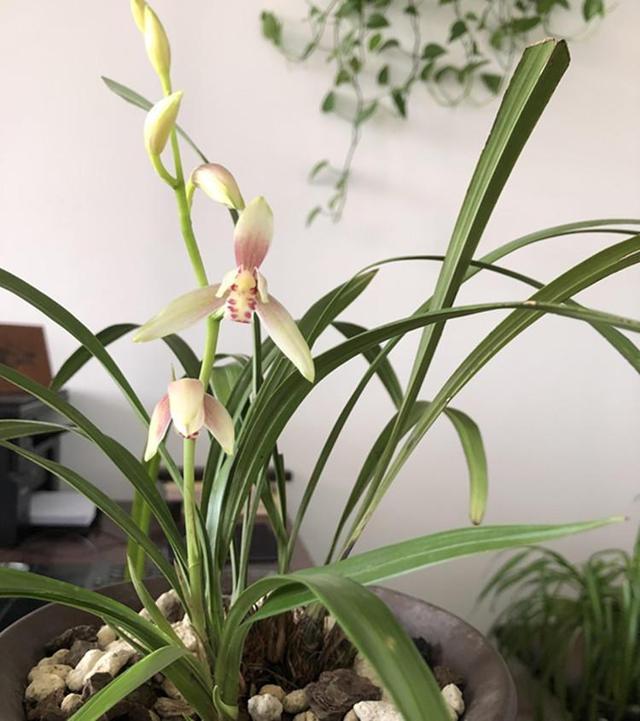The roots and leaves of potted orchids must be fed before they can explode.

We have talked a lot about the watering of orchids before, and flower friends all know that watering orchids is related to the growth of orchids. However, many flower friends do not understand that watering orchids should be carried out in both roots and leaves, and the roots and leaves of orchids should be "fed" before blossoms can burst.
1. Feed the root
Watering the root of the orchid is to insert the drip pipe into the plant material of each orchid basin and drip irrigation into the orchid basin according to the humidity of the plant material. However, the commonly used method of water supply for the root of orchid is basically similar to the method of pouring root water on the basin, that is, slow injection at the edge of the basin, pouring method and soaking method. Flower friends can use these three methods mixed.
(1) pelvic margin slow injection method
Is to use a kettle to slowly inject water along the edge of the basin, the advantage of this method is that the water will not reach the center of the leaf, the disadvantage is that the watering speed is slow, it is difficult to water through at one time, and it is necessary to repeatedly irrigate several times in order to achieve the effect of watering through.
When fertilizing, you can use orchid special organic liquid fertilizer, dilute 500 times, use a kettle to slowly inject from the edge of the basin, let the fertilizer and water slowly soak from the edge of the basin to the center of the basin. When using this method, watering and fertilization must be thoroughly watered, and the basin soil should be thoroughly drenched to prevent the basin soil from being loose and tight, dry and wet uneven.
(2) pouring method
This method is to spray water with the shower head of a spray pot or sprinkler to wet the whole orchid culture environment, which is most suitable for orchid nurseries cultivated in large areas of open air. The advantage of this method is to let the water seep from the soil surface to the orchid root, wet the orchid basin, and the water can pour through the whole orchid basin. The disadvantage is that water is easy to splash into the heart of the leaf, so use it carefully, otherwise it will break your heart.
Spray water should be fine, the amount should not be too much, with moist as the degree. It can be sprayed timely during the growing period of orchids, but be careful not to let more water droplets remain in the leaf sheath and bud. Water spraying time should be carried out in the morning and evening, if the temperature is particularly high, you can spray water on the basin and around, in order to cool down.
(3) immersion basin method
Is to soak 3/4 of the orchid basin together with the plant material in a pool, large basin or bucket filled with water. However, when soaking in the water, make sure that the surface of the water does not overflow the edge of the basin. At the beginning, the basin absorbs water faster and the water surface drops, so be patient with adding water until the water level is stable for 2-4 hours. After the orchid pot is taken out, it must be put in a ventilated place to dry for a while, and then put back to the normal position after the water droplets stop.
3. Feed the leaves
Orchids live in places with high humidity for a long time, which forms the physiological characteristics of leaves absorbing atomized water vapor. In particular, epiphytic orchids and orchids cultivated by air culture should pay more attention to leaf water supply. There are two common methods of blade water supply: spray and humidification.
The spray is sprayed with a sprayer and scattered directly on the orchid leaves, allowing them to be absorbed into the body through stomata. Humidification is to increase air humidity, can be used humidifier spray; under the orchid rack set up a reservoir or basin to increase water volatilization.
The air humidity around the orchid should be maintained at about 75% under normal conditions. In the orchid nursery cultivated in the open air, if there are trees and luxuriant branches and leaves around the orchid basin, and if there are low vegetation on the ground, the air humidity around the orchid basin can basically meet the above mixing requirements in summer and autumn.
Growing orchids on the balcony to increase air humidity is similar to the cooling measures used in greenhouses. Common methods are to build pools and sinks in the balcony, put containers such as water tanks, buckets and basins on the balcony, hang curtains or lay sponges and other water storage items, and increase water volatilization after pouring water.
- Prev

Whether watering orchids in spring or summer, you should pay attention to these times.
Raising orchids, we all know the saying, "raise orchids a little bit, watering for ten years." this watering problem has always been the top priority of raising orchids. However, there are still a lot of people can not grasp the problem of watering orchids. In fact, orchids are watered.
- Next

The yellow leaves of green apple mixed with beer turn green instantly.
The flower friends who raise green pineapple are all because the leaves of green pineapple can be kept green all the year round, which has a high appreciation value. However, flower friends who have raised green pineapple all know that green pineapple is very easy to have yellow leaves, so it suddenly reduces its appreciation.
Related
- Wuhan Hospital Iron Tree Blooming Result Was Instantly Frightened by the Gardener Master
- Which variety of camellia is the most fragrant and best? Which one do you like best?
- What is the small blue coat, the breeding methods and matters needing attention of the succulent plant
- Dormancy time and maintenance management of succulent plants during dormancy
- Minas succulent how to raise, Minas succulent plant pictures
- What are the varieties of winter succulent plants
- How to raise succulent plants in twelve rolls? let's take a look at some experience of breeding twelve rolls.
- Attention should be paid to water control for succulent plants during dormant period (winter and summer)
- Watering experience of twelve rolls of succulent plants
- Techniques for fertilizing succulent plants. An article will let you know how to fertilize succulent plants.

